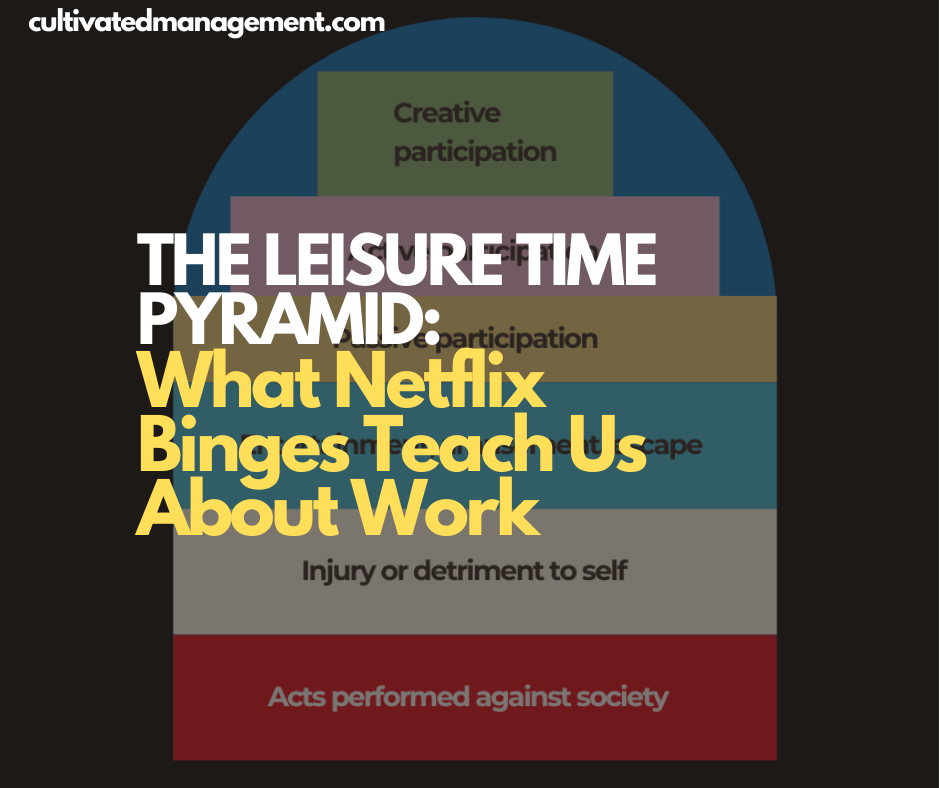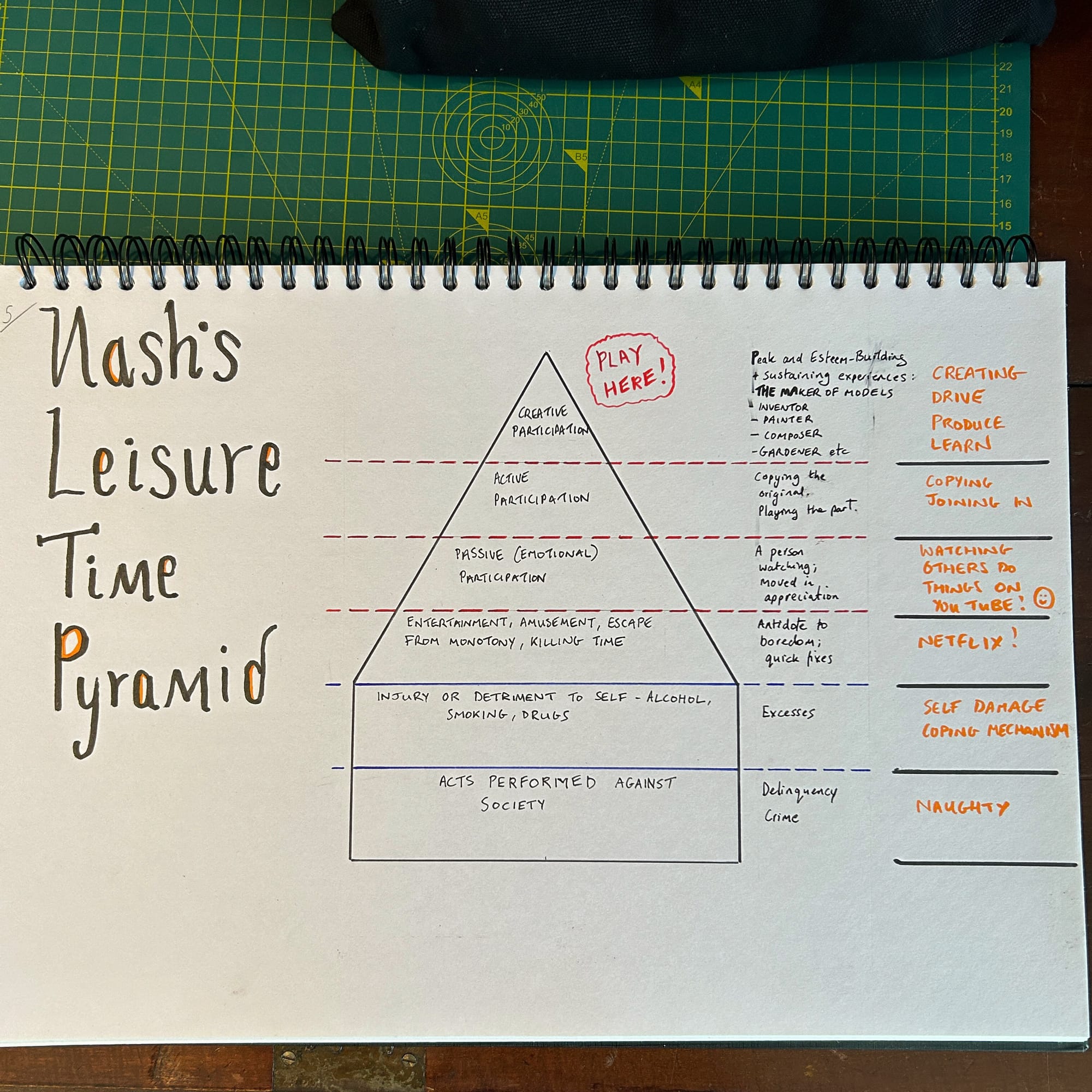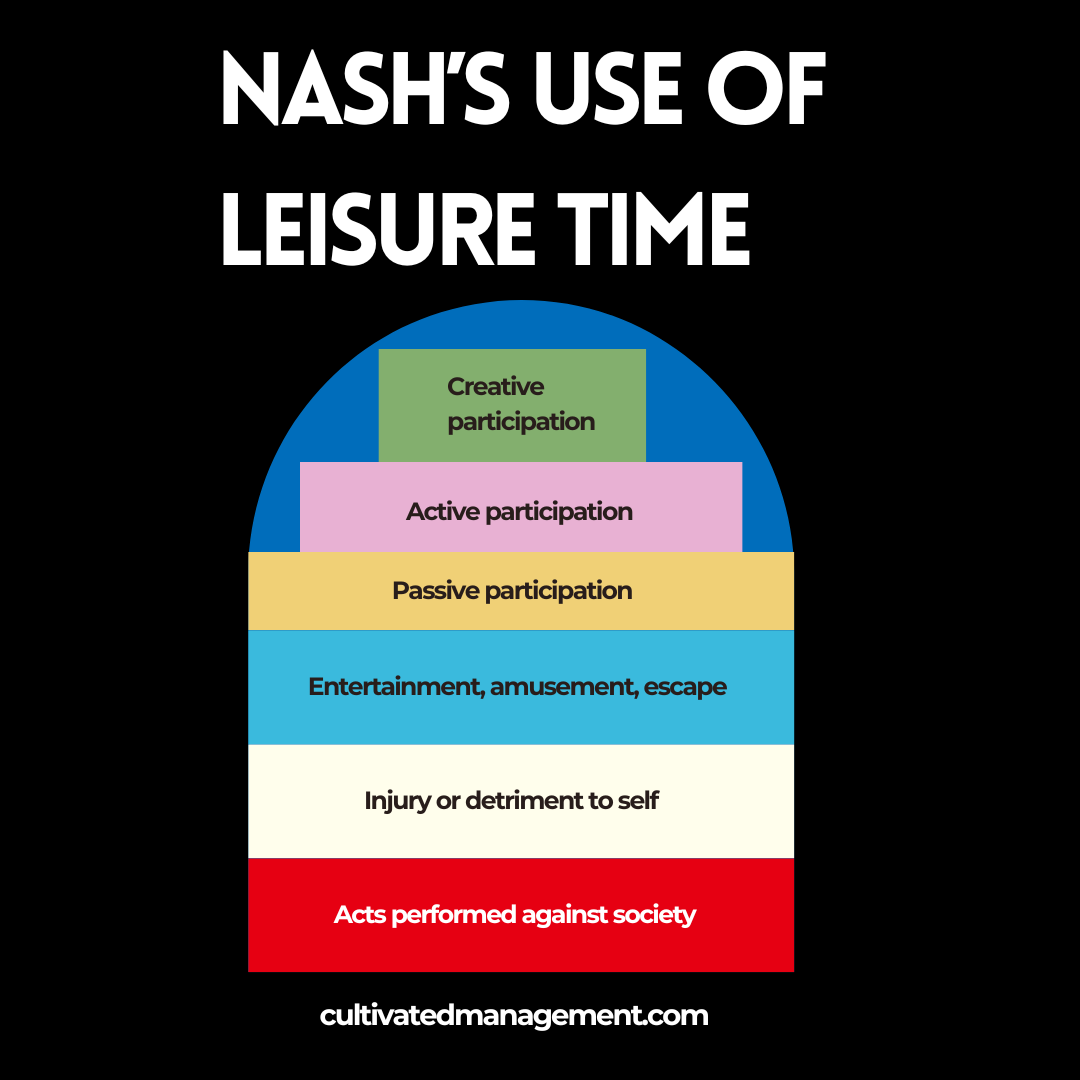
We all get some leisure time. Maybe not much — kids, careers, and life happen — but enough to choose how we spend it.
Nearly a century ago, Jay B. Nash created a model for how people use that time: the Leisure Time Pyramid.
Yes, it’s old. Yes, it’s flawed (little data, simplistic, very 1920s). But sometimes old models spark fresh reflection.
When I first read it, I caught myself thinking: I spend way too much time in the Escape zone.
And then I remembered the “Netflix Challenge” — a real game a team of engineers once played at work. It’s a perfect example of Nash’s pyramid in action.
Here's a podcast if that's your thing, or read on for more.
My own Learning Notes are also jotted about and towards the end of the post.
Nash’s Pyramid (In Plain English)
Imagine a triangle sitting on a rectangle. Six levels in total — from destructive to creative.

Here’s the quick tour:
Subzero: Acts Against Society
Crime, antisocial behaviour, active harm. Nash put this below the pyramid.
In business? Think sabotage, fraud, or people actively working against the company.
Zero: Excess / Self-Harm
Not harming others, but harming yourself — alcohol, drugs, burnout, toxic coping mechanisms.
I’ve seen it in workplaces that encourage unhealthy habits. One office even had a bar open at 1pm, and managers pushed staff to drink.
Level 1: Escape (Entertainment & Amusement)
Netflix binges. Social media scrolls. Killing time.
We all need escape sometimes — but too much leaves us stuck.
Level 2: Passive Participation
Watching others do meaningful work. Going to a concert. Watching cooking videos. Learning through observation.
It can inspire. But it’s still consumption.
Level 3: Active Participation
Copying a model. Following instructions. Doing the work, but within someone else’s framework.
At work, this is following a proven process. Valuable, but not yet inventive.
Level 4: Creative Participation
The top of the pyramid. Making, inventing, creating something new.
Writing. Painting. Starting a company. Designing a new process. Building a garden.
This is where Nash saw the pinnacle of leisure time being. Many of wish our jobs to be here too - creating lots of new value and skills - actively participating in the improvement and growth of the business.

Enter: The Netflix Challenge
I once joined a huge company as an interim VP of software engineering.
After a week, I discovered something shocking:
50% of the software team were competing in “The Netflix Challenge.”
The rules of this game? Watch as much Netflix as possible during work hours without being caught.
They had:
- A leaderboard of top watchers
- A top 20 shows list
- Ratings and time-tracking
It was… disturbingly well organised. Kudos for such effort.
Why? Because they were miserable. No clarity, no leadership, no alignment. So they escaped....and got paid well for it.
On Nash’s pyramid, this sits at Level 1: Escape.
From the company’s perspective, it was Subzero: acts against the business.
They weren’t lazy people. They were disengaged, bored, and undervalued. We soon fixed this problem.
What This Means for Work
Nash’s model is about leisure, but it maps neatly onto organisations:
- Creative participation (Level 4): The inventors, innovators, problem-solvers. You need these people to move the business forward.
- Active participation (Level 3): The builders. The ones who take proven processes and make them work.
- Passive participation (Level 2): Employees watching others succeed but not yet contributing fully. Sometimes useful for learning, but not enough on its own.
- Escape (Level 1): People killing time. Busy but not productive. Comfortable, but disengaged. Netflix challenge.
- Zero/Subzero: Burnout, coping mechanisms, or worse — behaviours that actively harm the business. Netflix challenge.
The Employee Engagement Trap
Here’s the kicker:
The Netflix Challenge team actually scored highly on the company’s engagement survey.
Why? Because they were comfortable. No pressure. No accountability. Plenty of time for binge-watching.
That’s why I don’t trust engagement surveys on their own. They measure how happy people are — not how much value they’re adding.
The better measure? Relationships. Conversations. Output. Value. With this we can understand what motivates people and how to help them move up the pyramid.
Moving People Up the Pyramid
As leaders, our job is to:
- Notice when people are stuck in Escape.
- Help them shift into Active Participation.
- Create space for Creative Participation.
Because most people don’t come to work to do nothing.
If they’re disengaged, it’s usually a symptom of weak management or broken systems.
Most people want to thrive and use their natural intelligence to solve problems, do good work and grow in their careers – all things that also help a business grow.
An Idea Worth Playing With
Nash’s model isn’t perfect. But it’s useful.
It forces us to ask:
- Where am I spending most of my leisure time?
- What do I need to do to move up the pyramid?
- Where is my team spending their energy at work?
- How can I help them climb higher?
Because whether it’s life or business, the goal is the same:
Spend less time escaping. Spend more time creating.
You'll see in my own learning note image at the top of this page, that this is what I did. The smiley face next to passive participation is where I was when I did this learning note - watching other people on YouTube do the things I wished to be doing.....

